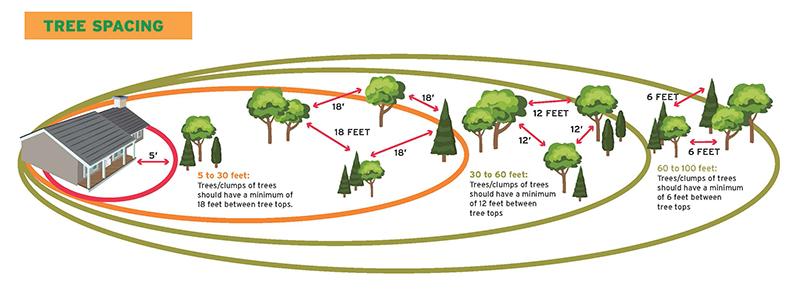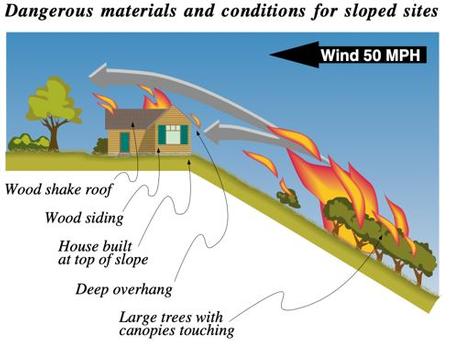Preparing Your Landscape
Preparing Your Landscape
Wildfire will always be a part of the California landscape
It is possible to design and maintain homes and property in ways that reduce vulnerability to wildfire. A key component of this protection is the proper placement and maintenance of plants around the home. While many are seeking plants that have a label that assures some level of fire resistance, it is important to recognize that any plant will burn under the right conditions and thus regular plant maintenance is critical.
To be able to reduce ember, radiant heat, and direct flame contact exposure to a home, develop and implement a three-zone strategy whereby the highest priorities and most restrictive measures are incorporated in the area closest to the home or other building of interest.
Incorporating these strategies does require some adjustment from the ways of the past, but with some small changes to the approach, it is possible to have both a beautiful landscape and a home that is more resilient to wildfire. Work from the house outward to make sure the structure itself is hardened against fire, then implement the guidelines here in concentric circles moving away from your structures.
To create a fire-resistant landscape:
- Design and implement defensible space
-
Create fuel breaks surrounding your house and within your garden.
-
Create space vertically and horizontally via plant placement and pruning.
-
Use hardscape and noncombustible materials around structures and to separate individual plants and groups of plants.
-
Use the right plants in the right places with fire, climate, and irrigation needs in mind.
-
Create plant islands that have similar sun, nutrient, and water needs.
- Replace combustible gates that attach to the house with materials that will not burn.
-
- Maintain your landscape
-
Keep your garden free from dry and dead wood, dry grasses, and leaf litter, especially near any structures.
-
Prune plants to provide horizontal and vertical space throughout your garden and surrounding structures.
-
Eliminate fire ladders. A grass fire can move up into shrubs and then into trees.
-
Hydrate plants with a water-wise irrigation system. Use non combustible mulches near to the house.
-
Defensible Space is only part of a larger landscape management strategy, designed to protect your home and property. The general surroundings leading up to your home must be considered as part of your wildfire preparedness planning.
Vegetation management
Treating fuels within the first five feet of structures is one of the most important aspects of wildfire hazard mitigation.
During wildfire, structures are threatened not only by the flaming front of the fire, but also by flaming embers that are lofted ahead of the fire front and can come into contact with receptive fuels (e.g vegetation or mulch next to the house), igniting new fires. Traditional defensible space tactics are designed to mitigate threats from the flaming front of the fire but do little to address vulnerabilities to embers on or directly adjacent to a structure. Without attention to ember-related risks, defensible space efforts only address a portion of the wildfire threat—especially during wind-driven fires in which embers are the primary source of fire spread.
Helping residents achieve greater wildfire resiliency will take a coupled approach and greater awareness of ember protection. Homes survive wildfire through a combination of 1) careful design and maintenance of landscaping; 2) awareness and management of combustible materials on the property (e.g., leaf litter, wood piles, and lawn furniture); and 3) incorporation of fire- and ember-resistant construction materials with appropriate installation and maintenance.
First responder access
Road access is crucial for your personal safety as well as those of first responders. Ensure that there is enough space for firefighting equipment to move onto your lot, as close as possible to your home and multiple access points to your parcel. During incidents, power lines or trees falling across roads are not uncommon. Work to develop:
- Two or more roads in and out of your parcel provides an alternate route in case of emergency. Dead-end roads should have a turnaround as approved by the local fire authority.
- Each road should be accessible year round and at least 20 feet wide
- Road grades should be less than 5% (5 foot rise for each 100-foot distance) are more accessible for larger fire equipment.
Steep slopes and wind
If the home is located on a steeper slope, in a drainage, in a windy area, or an area surrounded by unusually dense, tall, or combustible vegetation, thinning recommendations increase. Additionally, if the home is in a vegetation type that is especially prone to wildfire or has an active fire history, the greater the clearance and separation between plants and plant groupings the better. When the home is at the top of a slope keep in mind that fire and heat rise, allowing for pre-heating of the upslope fuels, resulting in the potential for more intense fire behavior. In these cases, greater effort should be directed at the area downslope of the home with even higher levels of fuels treatment given to the area below a deck. Recommendations based on the judgement of fire professionals are given below.
Under 20% slope: Space shrubs 2 x the height
20-40% slope: Space shrubs 4 x the height
Greater than 40%: Space shrubs 6 x the height
Wind is another factor to consider alongside aspect and slope. A south-facing slope with southerly winds can easily span the 30 foot "lean and clean" recommendation. Work with your local resource experts to install adequate measures if your property is at risk.
Decorative Features such as fencing, firewood and gazebos should be considered in laying out your landscape. As with other fuels, these are combustible materials which only serve to add heat and embers during wildfires. Use appropriate clearance or modify positioning for these features to reduce the threat from burning embers.
References
- Bethke, J., Bell, C., Gonzales, J., Lima, L., Long, A., and MacDonald, C. 2016. UCCE San Diego. Research Literature Review of Plant Flammability Testing, Fire-Resistant Plant Lists and Relevance of a Plant Flammability Key for Ornamental Landscape Plants in the Western States
- Nader et al (2007), Home Landscaping For Fire, UC Cooperative Extension
- Drill et al (2009), S.A.F.E Landscapes: Southern California Guidebook, UC Cooperative Extension





